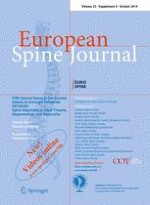01-10-2014 | Original Article
Percutaneous short fixation vs conservative treatment: comparative analysis of clinical and radiological outcome for A.3 burst fractures of thoraco-lumbar junction and lumbar spine
Published in: European Spine Journal | Special Issue 6/2014
Login to get accessAbstract
Purpose
The aim of the study is to use an algorithm previously published to decide whether to perform open surgery or percutaneous surgery with short fixation in patients with thoraco-lumbar junction and lumbar spine fractures, and to compare retrospectively surgical and conservative options of treatment.
Methods
Between 2005 and 2009, two groups of 25 patients were analyzed to compare retrospectively surgical and conservative option of treatment to assess perception of pain and to evaluate quality of life during treatment, to evaluate how quickly patients return to work and to their daily activities, to evaluate patients’ satisfaction. X-ray controls were performed to evaluate the fusion rate at 3 and 6 months and CT scans at 6 months.
Results
The surgical group had a better functional recovery, a better quality of life and returned to work earlier in comparison to the conservative group.
Conclusions
We can conclude that the percutaneous procedure seems to give better results in terms of satisfaction and return to normal activities, although both procedures guarantee excellent fusion rates.





